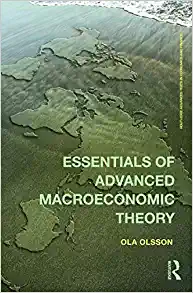


Your help will be highly appreciated
5. Let z be a random variable that takes on values in Z = (0, 1). Here, 1 denotes employment and 0 unemployment. Consider an arbitrary process of consumption (c,(z)],2, where c, : Z'+1 - RA. For this question, the probability of an unemployed individual finding a job is endogenous and depends on her search effort. For simplicity we will assume that the agent directly can influence, and therefore choose, the probability of finding a job, denoted by pr; that is P(z,+1 = 1/3, = 0) = pr. Let us, for simplicity, assume that once a job is found, it lasts for perpetuity and is unaffected by the agent's choice of p; that is P(z,+1 = 1|z, = 1) = 1, for all values of pr. We can summarize these assumptions concisely by a(?'+) = p,(?')2(z'), ifz, = 0, and a(3'+) = (s'), ifz = 1 where p,(s') is an agent's choice of search effort in period ?, after having observed history z'. A(z/+1) denotes as usual the probability of history at occurring. Lastly, an agent's preferences are given by Notice that the agent gains disutility o(p, (z)) of searching at "intensity" p,(z'). For simplicity we assume that D (0) = 0. (a) After any history z', define a continuation value in this economy. Denote this V(z'). (b) If z, = 0, derive a necessary condition for the agents' search effort in period t. Hint: Notice that if z, = 0, V(=) = "(c(=)) - o(p.()) + B(p.()V((z, 1)) + (1 - p.())V((',0))) Now, let us assume there is a government providing unemployment insurance and taxing labor income. More precisely, the government will collect all labor income once the agent is em- ployed, and always provide some sort of benefits equal to c,(z'). The government does so in order to maximize her own (expected present value) revenue, and such that the agent is given some minimum (expected present value) utility, Vo. However, the government must also recog- nize that the agent will freely decide how much she searches. The government's optimization problem is then given by J(Vo, 20) = max > > 8'(z,w - c,(=)12(=) (6) subject to Vo = _ _ B'tu(c,(=)) - (p,(=))12(=) (7) 1=0 JEZ ( 41 and also subject to the necessary condition derived in (b). (c) Provide the Bellman equation associated with the optimization problem above (no need for a proof). Hint: A good starting point is to derive the Bellman equation for zo = 1, and then for ZO = 0.4. Consider the following (very simple) consumption-savings problem with habits V(ao, c-1) = max E B'u(c - YC-1) (1) subject to cr + arti = w + (1 + r)an, 1==0, 1,... (2) with go and c-1 given, and y = [0, 1). (a) Provide the Bellman equation to the above problem (no proof needed). (b) Derive the first order conditions, apply the envelope theorem, and derive the Euler equation. Now, let us modify the problem in the following way, V (ao, do, C-1) = max [pu(c, - ya-1) (3) subject to C + an = w+ (1+r)a, 1 =0, 1, ... (4) & = H(a, CI-1), and as+1 = G(a, &,-1) (5) with ao, ao, and &_, given, and y e [0, 1). G(.) and H(.) are, simply, exogenously provided functions. (c) What is the Bellman equation associated with the problem above (no proof needed). (d) Derive the first order conditions, apply the envelope theorem, and derive the Euler equation. Let us now assume that the economy is populated by a continuum of individuals, all starting their lives with the same level of co, do, C-1. Moreover, a, and &, now happens to be average - or, as everyone is identical, representative - savings and consumption levels, respectively. (e) What is the relationship between the functions G(.), H(.), and the individual's policy functions for c, and a,+1? (For simplicity, denote the individual's policy functions as a' = g(a, a, a-,) and c = h(a, a, 6-1).) (f) The economy above is commonly referred to as "catching up with the Jones's". Can you (very briefly) explain why? Why is the Euler equation associated with this economy so different from the one with standard habits? Which one of these two economies ("habits" and "keeping up with the Jones's") do you believe is Pareto-optimal, and which one is not?1. Consider the following optimization problem V (k) = max(u(c) +e-" V(f() + (1 -5)k- c)) (a) What assumptions do we need on w, f and y to guarantee that there exists a unique V(.) satisfying the above Bellman equation? (b) In the equation above, one time-period is equal to one unit of time. Reformulate the equation such that one time-period equals A units of time. (c) What is the continuous-time formulation of the above equation? Hint: remember that lim .o(f( ha) - f(x))/h = S'(x)a. 2. Using words, briefly define the following concepts, and explain how we have put them to use in the course (Rendahl): (a) A complete metric space. (b) A norm, and in particular, the sup-norm. (c) The contraction mapping theorem. (d) The envelope theorem. 3. Consider a Lucas-tree type economy in which the endowment is growing stochastically and assume that agents have CRRA preferences. For tractability, assume that the endowment growth rate fol- lows a two-state Markov process. Suppose one- and two-period bonds are traded in this economy and define the term premium as the difference between the expected return from selling a two-period bond after holding it for one period and the return from a one-period bond. Provide an intuitive ex- planation for why the term premium is positive if and only if consumption growth exhibits negative serial correlation












